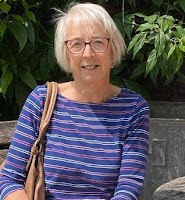Hello!
Today I'm welcoming my author friend Tim Walker to share his recently published novella The Trials of Arthur Whitty (15th July 2025). It's a really exciting project and has the most fabulous cover, but I'll let Tim do the explaining for you regarding the intent and purpose of the novella.
This
novella is the story of plain old Arthur Whitty, a man whose dreams are never
dull and whose vivid imagination and sense of humour carries him through a
series of sometimes challenging situations. Arthur has retired to a pair of
slippers and jigsaw table in a quiet cul-de-sac in Berkshire, England. He walks
his dog, Max, and lets his mind wander to a series of dreams in which he is
more daring, skilful and adventurous that his real-life humdrum self. He is an
irritant to his orderly wife, Emilia, and has succumbed to irksome cancer
treatment following a run-in with skin cancer.
Once
a date has been set for corrective surgery, Arthur sets his mind on organising
a real-life adventure – a bucket list trip to Machu Picchu in Peru where he
finds peace and a calming of the spirit. Arthur’s bullish nature carries him
through a series of situations but there is little the retired couple can do
about the onset of dementia. But Arthur is well supported by Emilia and their
daughter, Holly, as the family rally round to make his declining years as
comfortable as possible. And there’s always escape to his secret world of risk,
responsibility and danger. In his dreams, Arthur always wins.
The
author has drawn on personal experience and observations of elderly men in a
support group he helps run for Men’s Matters charity in Windsor,
Berkshire. Half of all royalties from the sales of this book will be donated to
Men’s Matters, who support older men by encouraging social interaction
and connecting them to health and wellbeing support services.
Here's a bit about Tim:
Tim
Walker is an independent author living near Windsor in the UK. Born in Hong
Kong in the Sixties, he grew up in Liverpool where he began his working life as
a trainee reporter on a local newspaper. He went on to attain an honours degree
in Communication Studies in South Wales before moving to London where he worked
in the newspaper publishing industry for ten years.
In
the mid-90s he opted to spend a couple of years doing voluntary work in Zambia
through VSO, running an educational book publishing development programme.
After this, he set up his own marketing and publishing business in Lusaka,
Zambia’s capital, then managed a mineral exploration company before returning
to the UK in 2009.
His
creative writing journey began in earnest in 2014, as a therapeutic activity
whilst recovering from cancer treatment. In addition to short stories, he
researched and wrote a five-book historical fiction series, A Light in the
Dark Ages. The series connects the end of Roman Britain to the story of
Arthur in an imaginative narrative. It starts with Abandoned, then Ambrosius:
Last of the Romans; Uther’s Destiny; Arthur Dux Bellorum and Arthur
Rex Brittonum, the last two books charting the life of an imagined
historical King Arthur.
More
recently, he has written a dual timeline historical novel set at Hadrian’s
Wall, Guardians at the Wall. His two books of short stories, Thames
Valley Tales and London Tales combine contemporary and historical
themes and are now available as audiobooks. Somewhere along the way, he
co-authored a three-book children’s series with his daughter, Cathy, The
Adventures of Charly Holmes.
Thank
you for reading The Trials of Arthur Whitty. Please leave a star rating
and review on Amazon and/or Goodreads so others can benefit from your
experience.
Tim’s Amazon author page: www.author.to/TimWalkerWrites
Goodreads: www.goodreads.com/author/show/678710.Tim_Walker
Tim’s website: www.timwalker1666.wixsite.com/website
Facebook Page: www.facebook.com/TimWalkerWrites
Instagram: www.instagram.com/timwalker1666
X (Twitter): www.twitter.com/timwalker1666
TikTok: www.tiktok.com/@timwalker804
BlueSky: www.bsky.app/profile/timwalker1666.bsky.social
My thanks to you for visiting today, Tim, and I wish you the best success with The Trials of Arthur Whitty.
Slainte!
p.s. I still have your Light in the Dark Ages novels on my Kindle which may someday get a re-read, especially if I ever go back to writing set in earlier centuries though the late Roman Britain period would require a lot of new study on my part!


















